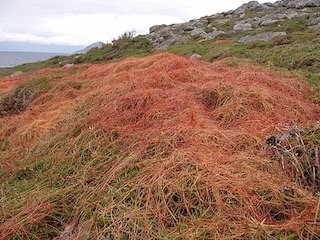 Watch out for the red stems of the parasitic plant Dodder scrambling over gorse and heather. It flowers between July and September.
Watch out for the red stems of the parasitic plant Dodder scrambling over gorse and heather. It flowers between July and September.
Photo: Wikimedia Commons (see below for full attribution)
Scientific name: Cuscuta epithymum
Other names: Devil’s Net, Red Tangle, Strangleweed, Fairy Hair
Conservation status: IUCN: Vulnerable
 Dodder, a climbing annual (very occasionally perennial) plant, is parasitic. It uses a number of hosts, but on The Lizard is most often found scrambling and twining through Gorse (Ulex spp.) or Heather (or Ling: Calluna vulgaris). Elsewhere in Great Britain it can also be found on chalk downs and stable sand dunes, as well as on heathlands. It is however declining, with reduction in these habitats being the most likely reason.
Dodder, a climbing annual (very occasionally perennial) plant, is parasitic. It uses a number of hosts, but on The Lizard is most often found scrambling and twining through Gorse (Ulex spp.) or Heather (or Ling: Calluna vulgaris). Elsewhere in Great Britain it can also be found on chalk downs and stable sand dunes, as well as on heathlands. It is however declining, with reduction in these habitats being the most likely reason.
Being a parasite, Dodder has no need of green chlorophyll, and its stems are a striking reddish colour. The flowers, appearing from July until the early autumn, are pink. It has no obvious leaves: these have become tiny scales on the stems.
Like others in its genus, Dodder has no roots. The seeds germinate near the soil surface and the seedling then winds itself round a suitable host, using appendages called haustoria to access the water and nutrients it needs from the host’s vascular system. If a seedling does not successfully attach to a host plant within ten days it dies: until then it is able to rely on reserves in the seed.
Did you know…?
…Dodder was once used as a traditional treatment for scabies
…its stems always twine anti-clockwise around its host plant
More information and references:
Grigson, G., 1955 (facsimile edition printed 1987). The Englishman’s Flora. J.M. Dent & Sons, London.
Rose, F. and O’Reilly, C., 2006. The Wild Flower Key, 2nd edition. Frederick Warne, London.
Stace, C., 2010. New Flora of the British Isles, 3rd edition. Cambridge University Press, Cambridge.
Published: July 2013
Author: Amanda Scott
Photo: Pintafontes from Pontevedra, Galiza [CC BY-SA]
